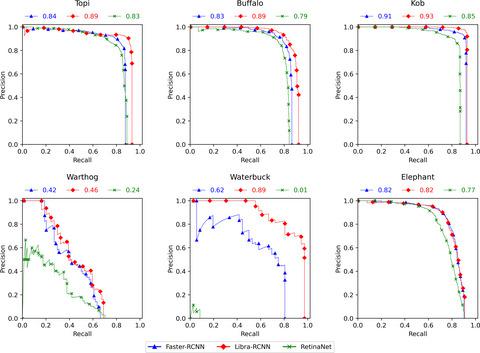当前位置:
X-MOL 学术
›
Remote Sens. Ecol. Conserv.
›
论文详情
Our official English website, www.x-mol.net, welcomes your
feedback! (Note: you will need to create a separate account there.)
Multispecies detection and identification of African mammals in aerial imagery using convolutional neural networks
Remote Sensing in Ecology and Conservation ( IF 3.9 ) Pub Date : 2021-08-10 , DOI: 10.1002/rse2.234 Alexandre Delplanque 1 , Samuel Foucher 2 , Philippe Lejeune 1 , Julie Linchant 1 , Jérôme Théau 3, 4
Remote Sensing in Ecology and Conservation ( IF 3.9 ) Pub Date : 2021-08-10 , DOI: 10.1002/rse2.234 Alexandre Delplanque 1 , Samuel Foucher 2 , Philippe Lejeune 1 , Julie Linchant 1 , Jérôme Théau 3, 4
Affiliation

|
Survey and monitoring of wildlife populations are among the key elements in nature conservation. The use of unmanned aerial vehicles and light aircrafts as aerial image acquisition systems is growing, as they are cheaper alternatives to traditional census methods. However, the manual localization and identification of species within imagery can be time-consuming and complex. Object detection algorithms, based on convolutional neural networks (CNNs), have shown a good capacity for animal detection. Nevertheless, most of the work has focused on binary detection cases (animal vs. background). The main objective of this study is to compare three recent detection algorithms to detect and identify African mammal species based on high-resolution aerial images. We evaluated the performance of three multi-class CNN algorithms: Faster-RCNN, Libra-RCNN and RetinaNet. Six species were targeted: topis (Damaliscus lunatus jimela), buffalos (Syncerus caffer), elephants (Loxodonta africana), kobs (Kobus kob), warthogs (Phacochoerus africanus) and waterbucks (Kobus ellipsiprymnus). The best model was then applied to a case study using an independent dataset. The best model was the Libra-RCNN, with the best mean average precision (0.80 ± 0.02), the lowest degree of interspecies confusion (3.5 ± 1.4%) and the lowest false positive per true positive ratio (1.7 ± 0.2) on the test set. This model was able to detect and correctly identify 73% of all individuals (1115), find 43 individuals of species other than those targeted and detect 84 missed individuals on our independent UAV dataset, with an average processing speed of 12 s/image. This model showed better detection performance than previous studies dealing with similar habitats. It was able to differentiate six animal species in nadir aerial images. Although limitations were observed with warthog identification and individual detection in herds, this model can save time and can perform precise surveys in open savanna.
中文翻译:

使用卷积神经网络对航空影像中的非洲哺乳动物进行多物种检测和识别
野生动物种群的调查和监测是自然保护的关键要素之一。无人机和轻型飞机作为航拍图像采集系统的使用正在增长,因为它们是传统人口普查方法的更便宜的替代品。然而,图像中物种的手动定位和识别可能既耗时又复杂。基于卷积神经网络 (CNN) 的对象检测算法已显示出良好的动物检测能力。尽管如此,大部分工作都集中在二进制检测案例(动物与背景)上。本研究的主要目的是比较三种最近的检测算法,以基于高分辨率航空图像检测和识别非洲哺乳动物物种。我们评估了三种多类 CNN 算法的性能:Faster-RCNN、Libra-RCNN 和 RetinaNet。六种物种被针对:topis (Damaliscus lunatus jimela )、水牛 ( Syncerus caffer )、大象 ( Loxodontaafricana )、kobus ( Kobus kob )、疣猪 ( Phacochoerus africanus ) 和水羚 ( Kobus ellipsiprymnus)。然后使用独立数据集将最佳模型应用于案例研究。最好的模型是 Libra-RCNN,在测试中具有最好的平均精度 (0.80 ± 0.02)、最低的种间混淆度 (3.5 ± 1.4%) 和最低的假阳性/真阳性比率 (1.7 ± 0.2)放。该模型能够检测并正确识别所有个体中的 73%(1115 个),在我们独立的无人机数据集上找到 43 个目标物种个体,并检测到 84 个遗漏个体,平均处理速度为 12 秒/图像。该模型显示出比以前处理类似栖息地的研究更好的检测性能。它能够在最低点航拍图像中区分六种动物。尽管在群体中观察到疣猪识别和个体检测的局限性,
更新日期:2021-08-10
中文翻译:

使用卷积神经网络对航空影像中的非洲哺乳动物进行多物种检测和识别
野生动物种群的调查和监测是自然保护的关键要素之一。无人机和轻型飞机作为航拍图像采集系统的使用正在增长,因为它们是传统人口普查方法的更便宜的替代品。然而,图像中物种的手动定位和识别可能既耗时又复杂。基于卷积神经网络 (CNN) 的对象检测算法已显示出良好的动物检测能力。尽管如此,大部分工作都集中在二进制检测案例(动物与背景)上。本研究的主要目的是比较三种最近的检测算法,以基于高分辨率航空图像检测和识别非洲哺乳动物物种。我们评估了三种多类 CNN 算法的性能:Faster-RCNN、Libra-RCNN 和 RetinaNet。六种物种被针对:topis (Damaliscus lunatus jimela )、水牛 ( Syncerus caffer )、大象 ( Loxodontaafricana )、kobus ( Kobus kob )、疣猪 ( Phacochoerus africanus ) 和水羚 ( Kobus ellipsiprymnus)。然后使用独立数据集将最佳模型应用于案例研究。最好的模型是 Libra-RCNN,在测试中具有最好的平均精度 (0.80 ± 0.02)、最低的种间混淆度 (3.5 ± 1.4%) 和最低的假阳性/真阳性比率 (1.7 ± 0.2)放。该模型能够检测并正确识别所有个体中的 73%(1115 个),在我们独立的无人机数据集上找到 43 个目标物种个体,并检测到 84 个遗漏个体,平均处理速度为 12 秒/图像。该模型显示出比以前处理类似栖息地的研究更好的检测性能。它能够在最低点航拍图像中区分六种动物。尽管在群体中观察到疣猪识别和个体检测的局限性,











































 京公网安备 11010802027423号
京公网安备 11010802027423号